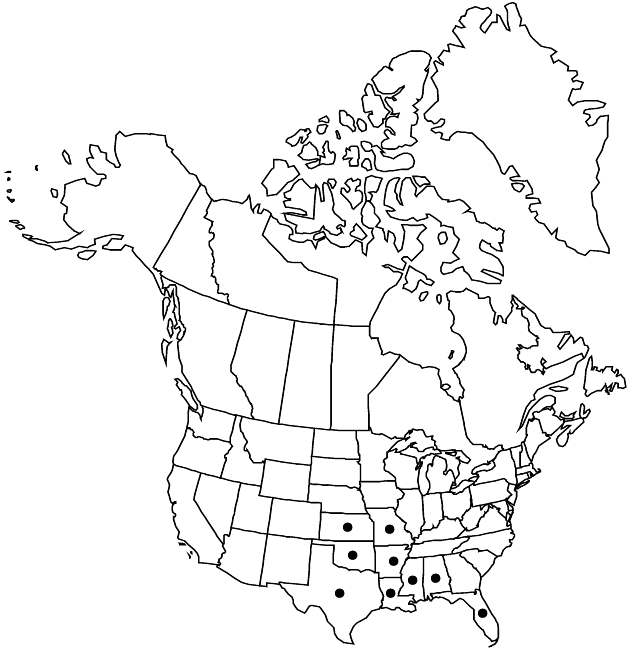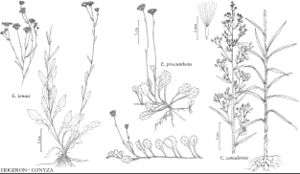Difference between revisions of "Erigeron tenuis"
Fl. N. Amer. 2: 175. 1841.
FNA>Volume Importer |
imported>Volume Importer |
||
| (6 intermediate revisions by 2 users not shown) | |||
| Line 8: | Line 8: | ||
}} | }} | ||
|common_names=Slender-leaf fleabane | |common_names=Slender-leaf fleabane | ||
| + | |special_status={{Treatment/ID/Special_status | ||
| + | |code=F | ||
| + | |label=Illustrated | ||
| + | }}{{Treatment/ID/Special_status | ||
| + | |code=E | ||
| + | |label=Endemic | ||
| + | }} | ||
|basionyms= | |basionyms= | ||
|synonyms= | |synonyms= | ||
| Line 24: | Line 31: | ||
|elevation=10–200 m | |elevation=10–200 m | ||
|distribution=Ala.;Ark.;Fla.;Kans.;La.;Miss.;Mo.;Okla.;Tex. | |distribution=Ala.;Ark.;Fla.;Kans.;La.;Miss.;Mo.;Okla.;Tex. | ||
| − | |discussion=<p>A plant reported as Erigeron tenuis disjunct in North Carolina is perhaps better identified as E. strigosus: pappus bristles on the ray cypselae are reduced and variable in number.</p> | + | |discussion=<p>A plant reported as <i>Erigeron tenuis</i> disjunct in North Carolina is perhaps better identified as <i>E. strigosus</i>: pappus bristles on the ray cypselae are reduced and variable in number.</p> |
|tables= | |tables= | ||
|references= | |references= | ||
| Line 33: | Line 40: | ||
-->{{#Taxon: | -->{{#Taxon: | ||
name=Erigeron tenuis | name=Erigeron tenuis | ||
| − | |||
|authority=Torrey & A. Gray | |authority=Torrey & A. Gray | ||
|rank=species | |rank=species | ||
| Line 47: | Line 53: | ||
|publication title=Fl. N. Amer. | |publication title=Fl. N. Amer. | ||
|publication year=1841 | |publication year=1841 | ||
| − | |special status= | + | |special status=Illustrated;Endemic |
| − | |source xml=https:// | + | |source xml=https://bitbucket.org/aafc-mbb/fna-data-curation/src/2e0870ddd59836b60bcf96646a41e87ea5a5943a/coarse_grained_fna_xml/V19-20-21/V20_799.xml |
|tribe=Asteraceae tribe Astereae | |tribe=Asteraceae tribe Astereae | ||
|genus=Erigeron | |genus=Erigeron | ||
Latest revision as of 20:05, 5 November 2020
Biennials or short-lived perennials, 10–45 cm; fibrous-rooted, caudices simple. Stems ascending (usually reddish proximally, branched distally), strigose, rarely hirsute proximally, eglandular. Leaves basal (commonly persistent) and cauline; basal blades oblanceolate to obovate or spatulate, 20–100(–130) × 4–20 mm, margins serrate or crenate to pinnately lobed, faces sparsely hirsute to strigoso-hirsute (hairs ascending), eglandular; cauline becoming narrower and entire (bases not clasping or subclasping), abruptly reduced near midstem. Heads (1–)3–20(–60) in loosely corymbiform arrays (usually from branches beyond midstem). Involucres (2–)2.5–4 × 5–10 mm. Phyllaries in 2–4 series, sparsely strigose, eglandular. Ray florets 60–120; corollas blue to pale lavender or white, drying blue to purplish, 3–5 mm, laminae not coiling or reflexing. Disc corollas 2–2.7 mm. Cypselae 1–1.2 mm, 2(–4)-nerved, faces sparsely strigose; pappi: outer of setae, inner of 11–15 bristles.
Phenology: Flowering mid Mar–May(–Jun, –Nov).
Habitat: Open oak, oak-pine, or pine woodlands, roadsides, fencerows, pastures, bottomland, sand or sandy clay, less common in clay
Elevation: 10–200 m
Distribution

Ala., Ark., Fla., Kans., La., Miss., Mo., Okla., Tex.
Discussion
A plant reported as Erigeron tenuis disjunct in North Carolina is perhaps better identified as E. strigosus: pappus bristles on the ray cypselae are reduced and variable in number.
Selected References
None.
